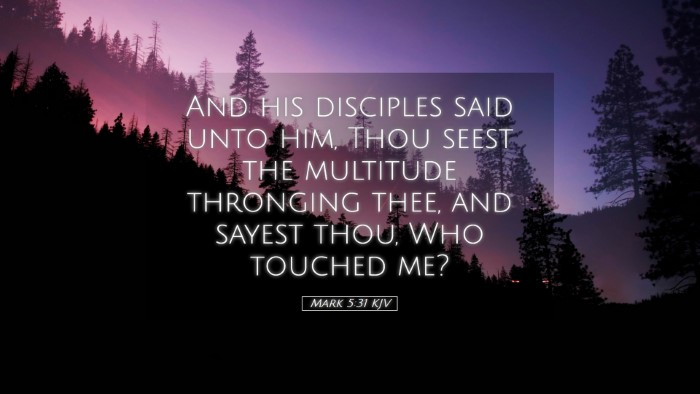Commentary on Mark 5:31
Mark 5:31 (ESV): "And his disciples said to him, 'You see the crowd pressing around you, and yet you say, “Who touched me?”'
Introduction
This passage occurs within a remarkable narrative of Jesus’ ministry, illustrating His authority over disease and death. As Jesus journeys to heal Jairus’ daughter, He pauses to address the touch of a woman who had suffered from a flow of blood for twelve years. The disciples' response to Jesus highlights the tension between spiritual insight and natural perception. In this commentary, we will explore the theological, historical, and practical implications of the verse, drawing from public domain commentaries including those of Matthew Henry, Albert Barnes, and Adam Clarke.
The Context of the Passage
To fully appreciate Mark 5:31, one must consider its surrounding context. Jesus has just healed a man possessed by demons (Mark 5:1-20) and is now on His way to heal Jairus' daughter (Mark 5:22-43). The crowd pressing around Him illustrates both the popularity of His ministry and the desperate human need that draws people to Him. The dynamics of this narrative remind us that individual needs can be met amid collective urgency.
Disciples’ Perspective
The disciples’ question reflects their bemusement at Jesus’ inquiry, which appears to disregard the crowd's physical presence. This reaction highlights a few key insights:
-
Human Understanding: The disciples operated from a perspective dominated by physical limitations. They could not perceive the spiritual significance of the touch that had occurred.
-
Spiritual Distrust: Their response can also reflect a lack of understanding of Jesus’ divine nature. They were still learning that Christ’s awareness transcends human limitations.
Analysis of Jesus’ Question
When Jesus asks, "Who touched me?", He is not seeking information in a human sense. Instead, He is inviting a deeper recognition of faith and power:
-
Recognizing Faith: This question shifts attention from the crowd to the individual who touched Him with faith. The fact that Jesus knew that power had gone out from Him indicates that true faith activates divine power.
-
Calling for Acknowledgment: Jesus desired the woman to acknowledge her healing publicly, thereby affirming her faith and restoring her socially and spiritually.
-
Demonstration of Divine Awareness: The question emphasizes Jesus’ omniscience. While He walked among them in flesh, He remained fully aware of personal spiritual needs.
Theological Implications
Several theological themes emerge from Mark 5:31, relevant to modern applications:
-
Jesus’ Empathy: This moment underscores Christ’s compassion, as He is deeply aware of individual suffering despite the multitude. It challenges the church to remember the importance of individual attention amidst communal ministry.
-
Faith and Healing: The woman’s faith was crucial for her healing, emphasizing theologically that faith initiates divine action. This concept resonates with the teaching of salvation by faith alone.
-
Authority of Christ: As both divine and human, Jesus demonstrates His authority over the physical and spiritual realms. He attends to each person's needs uniquely, teaching that every individual is valuable in the Kingdom of God.
Practical Applications for Pastors and Scholars
The verse offers profound insights for preachers, theologians, and lay leaders in the church:
-
Preach with Focus on Individual Needs: Pastors should remember that while congregations gather in thousands, each person presents unique needs and issues before God.
-
Encourage Faith-Based Healing: Promote the concept that faith is fundamental for healing and restoration, whether spiritually, emotionally, or physically.
-
Emphasize Relationship Over Ritual: Christ's inquiry invites a deeper relationship with Him; facilitate environments where individuals can acknowledge their faith and struggles openly.
Conclusion
Mark 5:31 serves as a powerful reminder of the intersection between faith and healing, encouraging believers to approach Christ with their burdens while understanding His divine awareness and compassion. In this passage, the individual is uplifted, showcasing that even within a throng, Jesus sees the one who truly seeks Him. For pastors, students, and theologians, this verse encourages a deeper exploration of individuals' spiritual journeys and the profound ways faith activates the power of Christ.


